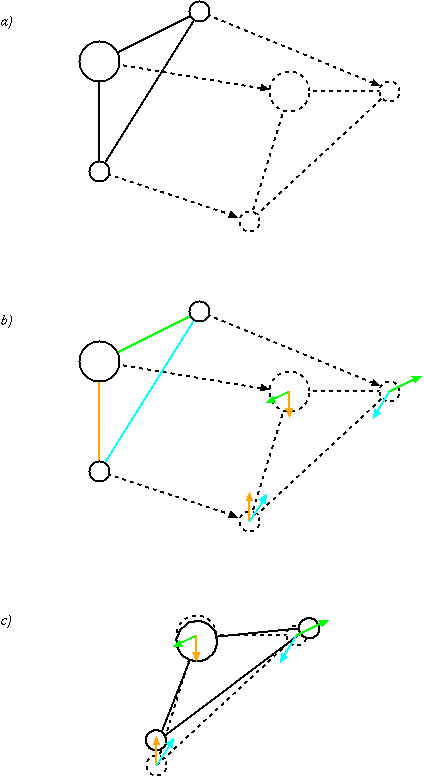|
Multibody System
Multibody system is the study of the dynamic behavior of interconnected rigid or flexible bodies, each of which may undergo large translational and rotational displacements. Introduction The systematic treatment of the dynamic behavior of interconnected bodies has led to a large number of important multibody formalisms in the field of mechanics. The simplest bodies or elements of a multibody system were treated by Newton (free particle) and Euler (rigid body). Euler introduced reaction forces between bodies. Later, a series of formalisms were derived, only to mention Lagrange’s formalisms based on minimal coordinates and a second formulation that introduces constraints. Basically, the motion of bodies is described by their kinematic behavior. The dynamic behavior results from the equilibrium of applied forces and the rate of change of momentum. Nowadays, the term multibody system is related to a large number of engineering fields of research, especially in robotics and vehi ... [...More Info...] [...Related Items...] OR: [Wikipedia] [Google] [Baidu] |
Translation (physics)
In Euclidean geometry, a translation is a geometric transformation that moves every point of a figure, shape or space by the same distance in a given direction. A translation can also be interpreted as the addition of a constant vector to every point, or as shifting the origin of the coordinate system. In a Euclidean space, any translation is an isometry. As a function If \mathbf is a fixed vector, known as the ''translation vector'', and \mathbf is the initial position of some object, then the translation function T_ will work as T_(\mathbf)=\mathbf+\mathbf. If T is a translation, then the image of a subset A under the function T is the translate of A by T . The translate of A by T_ is often written A+\mathbf . Horizontal and vertical translations In geometry, a vertical translation (also known as vertical shift) is a translation of a geometric object in a direction parallel to the vertical axis of the Cartesian coordinate system. Often, vertical translations ar ... [...More Info...] [...Related Items...] OR: [Wikipedia] [Google] [Baidu] |
N-body Simulation
In physics and astronomy, an ''N''-body simulation is a simulation of a dynamical system of particles, usually under the influence of physical forces, such as gravity (see ''n''-body problem for other applications). ''N''-body simulations are widely used tools in astrophysics, from investigating the dynamics of few-body systems like the Earth-Moon-Sun system to understanding the evolution of the large-scale structure of the universe. In physical cosmology, ''N''-body simulations are used to study processes of non-linear structure formation such as galaxy filaments and galaxy halos from the influence of dark matter. Direct ''N''-body simulations are used to study the dynamical evolution of star clusters. Nature of the particles The 'particles' treated by the simulation may or may not correspond to physical objects which are particulate in nature. For example, an N-body simulation of a star cluster might have a particle per star, so each particle has some physical significa ... [...More Info...] [...Related Items...] OR: [Wikipedia] [Google] [Baidu] |
Holonomic Constraints
In classical mechanics, holonomic constraints are relations between the position variables (and possibly time) that can be expressed in the following form: :f(u_1, u_2, u_3,\ldots, u_n, t) = 0 where \ are the ''n'' generalized coordinates that describe the system. For example, the motion of a particle constrained to lie on the surface of a sphere is subject to a holonomic constraint, but if the particle is able to fall off the sphere under the influence of gravity, the constraint becomes non-holonomic. For the first case, the holonomic constraint may be given by the equation :r^2-a^2=0 where r is the distance from the centre of a sphere of radius a, whereas the second non-holonomic case may be given by :r^2 - a^2 \geq 0 Velocity-dependent constraints (also called semi-holonomic constraints) such as :f(u_1,u_2,\ldots,u_n,\dot_1,\dot_2,\ldots,\dot_n,t)=0 are not usually holonomic. Holonomic system In classical mechanics a system may be defined as holonomic if all constraints ... [...More Info...] [...Related Items...] OR: [Wikipedia] [Google] [Baidu] |
Constraint Algorithm
In computational chemistry, a constraint algorithm is a method for satisfying the Newtonian motion of a rigid body which consists of mass points. A restraint algorithm is used to ensure that the distance between mass points is maintained. The general steps involved are: (i) choose novel unconstrained coordinates (internal coordinates), (ii) introduce explicit constraint forces, (iii) minimize constraint forces implicitly by the technique of Lagrange multipliers or projection methods. Constraint algorithms are often applied to molecular dynamics simulations. Although such simulations are sometimes performed using internal coordinates that automatically satisfy the bond-length, bond-angle and torsion-angle constraints, simulations may also be performed using explicit or implicit constraint forces for these three constraints. However, explicit constraint forces give rise to inefficiency; more computational power is required to get a trajectory of a given length. Therefore, internal co ... [...More Info...] [...Related Items...] OR: [Wikipedia] [Google] [Baidu] |
Degrees Of Freedom (mechanics)
In physics, the degrees of freedom (DOF) of a mechanical system is the number of independent parameters that define its configuration or state. It is important in the analysis of systems of bodies in mechanical engineering, structural engineering, aerospace engineering, robotics, and other fields. The position of a single railcar (engine) moving along a track has one degree of freedom because the position of the car is defined by the distance along the track. A train of rigid cars connected by hinges to an engine still has only one degree of freedom because the positions of the cars behind the engine are constrained by the shape of the track. An automobile with highly stiff suspension can be considered to be a rigid body traveling on a plane (a flat, two-dimensional space). This body has three independent degrees of freedom consisting of two components of translation and one angle of rotation. Skidding or drifting is a good example of an automobile's three independent degrees ... [...More Info...] [...Related Items...] OR: [Wikipedia] [Google] [Baidu] |
Spherical Joint
In an automobile, ball joints are spherical bearings that connect the control arms to the steering knuckles, and are used on virtually every automobile made. They bionically resemble the ball-and-socket joints found in most tetrapod animals. A ball joint consists of a bearing stud and socket enclosed in a casing; all these parts are made of steel. The bearing stud is tapered and threaded, and fits into a tapered hole in the steering knuckle. A protective encasing prevents dirt from getting into the joint assembly. Usually, this is a rubber-like boot that allows movement and expansion of lubricant. Motion-control ball joints tend to be retained with an internal spring, which helps to prevent vibration problems in the linkage. The "offset" ball joint provides means of movement in systems where thermal expansion and contraction, shock, seismic motion, and torsional motions, and forces are present. Theory A ball joint is used for allowing free rotation in two planes at the sa ... [...More Info...] [...Related Items...] OR: [Wikipedia] [Google] [Baidu] |
Revolute Joint
A revolute joint (also called pin joint or hinge joint) is a one- degree-of-freedom kinematic pair used frequently in mechanisms and machines. The joint constrains the motion of two bodies to pure rotation along a common axis. The joint does not allow translation, or sliding linear motion, a constraint not shown in the diagram. Almost all assemblies of multiple moving bodies include revolute joints in their designs. Revolute joints are used in numerous applications such as door hinges, mechanisms, and other uni-axial rotation devices. A revolute joint is usually made by a pin or knuckle joint, through a rotary bearing. It enforces a cylindrical contact area, which makes it a lower kinematic pair, also called a full joint. However, If there is any clearance between the pin and hole (as there must be for motion), so-called surface contact in the pin joint actually becomes line contact. The contact between the inner and outer cylindrical surfaces is usually assumed to be fr ... [...More Info...] [...Related Items...] OR: [Wikipedia] [Google] [Baidu] |
Prismatic Joint
A prismatic joint is a one- degree-of-freedom kinematic pair which constrains the motion of two bodies to sliding along a common axis, without rotation; for this reason it is often called a slider (as in the slider-crank linkage) or a sliding pair. They are often utilized in hydraulic and pneumatic cylinders. A prismatic joint can be formed with a polygonal cross-section to resist rotation. See for example the dovetail joint and linear bearings. See also * Cylindrical joint * Degrees of freedom (mechanics) * Kinematic pair * Kinematics * Mechanical joint * Revolute joint A revolute joint (also called pin joint or hinge joint) is a one- degree-of-freedom kinematic pair used frequently in mechanisms and machines. The joint constrains the motion of two bodies to pure rotation along a common axis. The joint does ... References Kinematics Rigid bodies {{classicalmechanics-stub ... [...More Info...] [...Related Items...] OR: [Wikipedia] [Google] [Baidu] |
Cardan Joint
A universal joint (also called a universal coupling or U-joint) is a joint or coupling connecting rigid shafts whose axes are inclined to each other. It is commonly used in shafts that transmit rotary motion. It consists of a pair of hinges located close together, oriented at 90° to each other, connected by a cross shaft. The universal joint is not a constant-velocity joint. U-joints are also sometimes called by various eponymous names, as follows: * Cardan joint, after Gerolamo Cardano, a polymath of the 16th century who contributed to knowledge of various clever mechanisms, including gimbals * Hooke joint or Hooke's joint, after Robert Hooke, a polymath of the 17th century who contributed to knowledge of various clever mechanisms * Spicer joint, after Clarence W. Spicer and the Spicer Manufacturing Company, who manufactured U joints * Hardy Spicer joint, after the Hardy Spicer brand, a successor to the Spicer brand History The main concept of the universal joint i ... [...More Info...] [...Related Items...] OR: [Wikipedia] [Google] [Baidu] |
Example MBS
Example may refer to: * '' exempli gratia'' (e.g.), usually read out in English as "for example" * .example, reserved as a domain name that may not be installed as a top-level domain of the Internet ** example.com, example.net, example.org, example.edu, second-level domain names reserved for use in documentation as examples * HMS ''Example'' (P165), an Archer-class patrol and training vessel of the Royal Navy Arts * ''The Example'', a 1634 play by James Shirley * ''The Example'' (comics), a 2009 graphic novel by Tom Taylor and Colin Wilson * Example (musician), the British dance musician Elliot John Gleave (born 1982) * ''Example'' (album), a 1995 album by American rock band For Squirrels See also * * Exemplar (other), a prototype or model which others can use to understand a topic better * Exemplum, medieval collections of short stories to be told in sermons * Eixample The Eixample (; ) is a district of Barcelona between the old city (Ciutat Vella) and ... [...More Info...] [...Related Items...] OR: [Wikipedia] [Google] [Baidu] |
Rapid Prototyping
Rapid prototyping is a group of techniques used to quickly fabricate a scale model of a physical part or assembly using three-dimensional computer aided design (CAD) data. Construction of the part or assembly is usually done using 3D printing or "additive layer manufacturing" technology. The first methods for rapid prototyping became available in the mid 1987 and were used to produce models and prototype parts. Today, they are used for a wide range of applications and are used to manufacture production-quality parts in relatively small numbers if desired without the typical unfavorable short-run economics. This economy has encouraged online service bureaus. Historical surveys of RP technology start with discussions of simulacra production techniques used by 19th-century sculptors. Some modern sculptors use the progeny technology to produce exhibitions and various objects. The ability to reproduce designs from a dataset has given rise to issues of rights, as it is now possibl ... [...More Info...] [...Related Items...] OR: [Wikipedia] [Google] [Baidu] |



.jpg)


